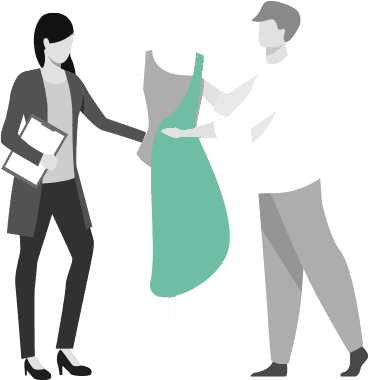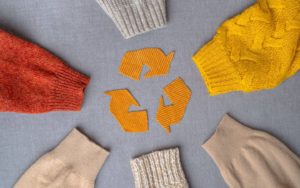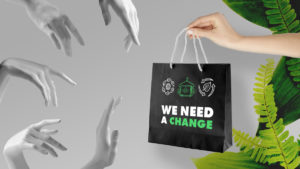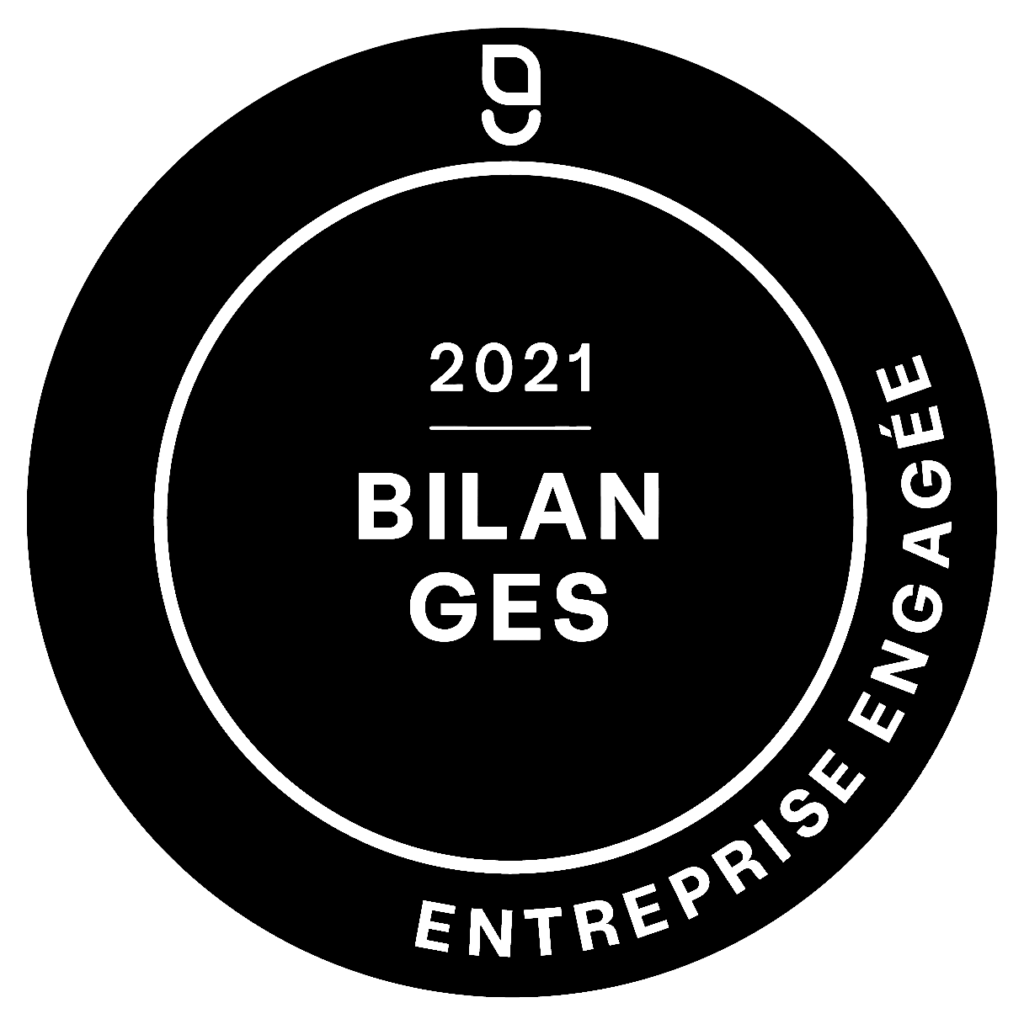Even today, the terms “slow fashion” and “ethical fashion” remain a bit vague in the minds of consumers, as only 25% of the French market has heard of slow fashion*. Slow fashion was born with the aim of countering the harmful effects of its opposite: fast fashion. Its guiding principle is to place respect for the environment and workers at its epicentre in order to offer ethical and sustainable fashion. Slow fashion says “Stop!” to overproduction and overconsumption. The latter is gaining ground and has gradually become mainstream in the fashion world.
In order to understand how slow fashion provides answers to the immense problems of the modern textile industry, we will first define fast fashion.
WHAT IS FAST FASHION?
 Fast fashion designates a phenomenon of very rapid renewal of clothing collections in the same season, or even every month, a transitory and disposable fashion. It is characterized by a rapid and incessant overproduction of clothing. Appeared in the 90s, the fast fashion movement is now carried by ready-to-wear brands around the world. As examples, we find Zara, H&M or Primark. These lattesr offer clothes inspired by trends spotted during Fashion Week shows at extremely low prices. But at what cost for humanity and the environment? With 1.7 billion tonnes of greenhouse gases emitted each year **, the fashion industry is the second most polluting industry in the world.
Fast fashion designates a phenomenon of very rapid renewal of clothing collections in the same season, or even every month, a transitory and disposable fashion. It is characterized by a rapid and incessant overproduction of clothing. Appeared in the 90s, the fast fashion movement is now carried by ready-to-wear brands around the world. As examples, we find Zara, H&M or Primark. These lattesr offer clothes inspired by trends spotted during Fashion Week shows at extremely low prices. But at what cost for humanity and the environment? With 1.7 billion tonnes of greenhouse gases emitted each year **, the fashion industry is the second most polluting industry in the world.
“Fashion is the language of the moment. “
– Miuccia Prada –
HOW DOES FAST FASHION POLLUTE?
In order to better understand what the pollution of the textile industry consists of, we must keep in mind that the direct consequences on the environment emanate from the manufacture of raw materials, their transformation to the transport and even the maintenance of our products. synthetic clothing (around 500,000 tonnes of plastic micro particles are released into the oceans each year). Did you know, for example, that the production of a standard cotton sweatshirt consumes 8,000 liters of water and 600 grams of chemicals or that jeans and their components travel on average 65,000 kilometers, or 1.5 times the round the Earth ***. Knowing that in total each year 100 billion clothes are produced per year ****… Slow fashion is proving to be the only alternative to this opportunistic, polluting and ultimately dangerous textile industry for humanity. It brings an ethical response to our nature and in the long term, to our species.
WHAT IS SLOW FASHION?
 “We are what we wear”: “We are what we wear”. Slow fashion carries strong values revolving around the empowerment of each of us for our planet and its future. As soon as we realize what we are wearing, we can no longer ignore the impact that fast fashion has on our planet and our society. Slow fashion aims to put ethics and sustainability at the center of the entire process: from raw materials, through production and supply chain to the sale of the garment and its end of life. The primary objective of this movement is to put an end to waste, to preserve our environment and to take people into account: in short, an ethical, sustainable and committed fashion.
“We are what we wear”: “We are what we wear”. Slow fashion carries strong values revolving around the empowerment of each of us for our planet and its future. As soon as we realize what we are wearing, we can no longer ignore the impact that fast fashion has on our planet and our society. Slow fashion aims to put ethics and sustainability at the center of the entire process: from raw materials, through production and supply chain to the sale of the garment and its end of life. The primary objective of this movement is to put an end to waste, to preserve our environment and to take people into account: in short, an ethical, sustainable and committed fashion.
THOUGHTFUL CONSUMPTION
Thoughtful consumption: sustainable fashion. From the documentary “Clothes, don’t throw it away any more!” broadcast in 2016 on France 5, a woman buys an average of 30 kg of clothing per year in France, of which less than a quarter will be recycled and only 30% will be regularly worn. However, an Opinion Way study in 2014 also revealed that 86% of French people like to take their time before buying and that this amplifies their pleasure. In fact, these figures mean that the French prefer to think before acting. Fast-fashion is therefore in total contradiction to the wishes and nature of consumers in this country, and probably many others. Consumption thoughtful and in limited quantity is the only viable and responsible alternative today if we wish to put an end to the overproduction, as well as to the overexploitation of our natural resources.
“Clothes aren’t going to change the world, the women who wear them will. “
– Anne Klein –
ETHICS, SUSTAINABILITY AND PROFITABILITY
Favoring quality over quantity gives an ethical, sustainable but also profitable result. In other words: everything current fashion needs to take responsibility and regain its original values. Quality, protection of the environment and workers, fairness, limited production, are all values representing the brands of slow fashion.
Industry, brands and consumers take time to change their behavior and their habits, but awareness of all stakeholders is underway. The brands are multiplying the actions, such as the signing by different brands of the Fashion Pact or even Jules who foresees that by 2030, 100% of materials will come from recycled products, fibers and materials; to reduce their greenhouse gas (local production), have a Zero Waste approach (produce only what they are able to sell) while committing to a real CSR plan. Customers are also changing in their way of consuming by turning to second hand (4/10 French have converted *****), by favoring eco-labels and eco-committed brands (over the 12 in recent months, searches for eco-responsible clothing have increased by 50% in France ******). However, one of the main obstacles to responsible purchasing is the lack of information: but here again applications such as Clear Fashion, the Yuka of fashion, help consumers navigate their way.
“Buy Less. Choose Well. Make it last ”
– Vivienne Westwood –
The government is also trying to provide some answers by prohibiting, for example, the destruction of unsold items (which also generates a loss of value) and more generally by promulgating its law on the circular economy.
Beyond this awareness and the initiatives already launched, we must support and accompany this change. We must act so that the fashion industry transforms radically and sustainably to adapt to new consumer expectations, give meaning to the work of each employee, better protect all actors in the production chain, reduce its footprint on the planet and rediscover the paths of innovation and profitability and thus become eco-profitable.
Fashion data, thanks to its Steps and his solutions, puts smart data at the service of this new Zero Waste fashion business model.
Sources:
* emarketing
** wwf study on “fast fashion” published in 2017
*** The world
**** Novethic
***** Fashion Network
****** Fashion Network


















